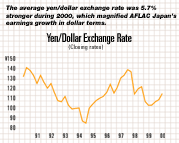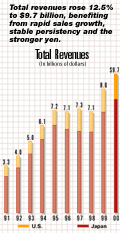
The Impact of the Yen/Dollar Exchange Rate

Click on Chart to
view a larger version
|
Fluctuations in the yen's value tend to distort our operating results in dollar terms. However, it's important to note that when preparing financial reports to shareholders, we do not convert currencies. Instead, we translate AFLAC Japan's yen-based financial statements into dollars. Therefore, AFLAC is largely unaffected by changes in the yen's value in economic terms although its relative strength or weakness can magnify or suppress reported results.
On average, the yen increased in value, or strengthened, against the dollar last year. During 2000, the yen averaged 107.83 to the dollar, which was 5.7% stronger than the comparable rate of 113.96 in 1999. We translate statements of earnings using the average exchange rate for the period. When the average yen/dollar exchange rate is stronger than the preceding year, as it was in 2000, it magnifies AFLAC Japan's rates of growth in dollar terms. However, the yen began to decrease in value, or weaken, against the dollar toward the end of the year, finishing 2000 at 114.75, or 10.8% weaker than the 1999 year-end rate of 102.40. Because we translate our balance sheets using the period-end exchange rate, balance-sheet items were penalized by the weaker year-end rate. Below are some highlights on a dollar basis:

Click on Chart to
view a larger version
|
- New annualized premium sales rose 20.4% to $921 million, compared with $765 million in 1999.
- Premium income advanced 13.2% to $6.7 billion, compared with $5.9 billion in 1999.
- Net investment income was $1.3 billion, up 13.5% from $1.1 billion in 1999.
- Total revenues increased 13.3% to $8.0 billion, compared with $7.0 billion a year ago.
- Pretax operating earnings were up 18.6% to $771 million, compared with $651 million in 1999.
|

